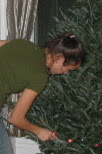Wednesday, December 22, 2004
Snow
Well Einstein, salt does not move snow. For some reason, Cincinnati has a total of 5 plows for the city. They think that by salting the roads that will take care of things. Now, coming from a land of snow, where Igloos are built and people wear snowshoes to work, there are plows. When it snows, the front of the truck plows and the back poops out salt. And ya know what? We don't have the problems that this town has. As soon as it starts snowing the plows are on the road. And what happened today would just be another winter day. It is winter. It snows. PLOW THE $%&#ing ROADS!
Okay, and just now the weather people --- "There are 60-80 salt trucks on the road." SALT TRUCKS! AGAIN, SALT DOES NOT MOVE SNOW. No mention of plows... I really don't get it.
Sunday, December 19, 2004
Luminaria...
On Christmas Eve at home, some streets do this as a symbol of lighting the way for Jesus. That is kind of a cool tradition. The answer to my question (seeing that it is not yet Christmas eve, and thinking that my endless years schooled at Catholic institutions was failing me) was, "Oh (you dumbass), this is what we do in this neighborhood once a year. It's called Luminaria. And we all put these lights out, there is caroling in the square, and hot chocolate. It is paid for by the town council."
"Oh." I said, and I continue to tell the woman what I just stated about it being a Christmas eve tradition. "Well, this is to include everyone from all denominations."
Okay. Now, this little Stepford area that I live in drives me nuts. First, and this really does not pertain specifically to this neighborhood, Christmas is a Christian holiday. I bet half of what people do - have no idea why they are doing it, such as these bags of lights. Second, let's sing carols in the public square - which are songs about the birth of Jesus... that is sure not to leave anyone from a different denomination out. Third, a Christian tradition of "lighting the way" paid for by the town...
-sigh- I dunno.
Here is a cursory history of luminaries.
Down through the ages, light from fire has served as a destination beacon for weary travelers. Two thousand years ago shepherds marked the way to the manger of the Christ Child with small bonfires. For centuries, to symbolize this tradition, the people of Mexico have gathered on Christmas Eve to light large bonfires in the village commons, to pray, sing and welcome the Christ Child. After the celebration, smaller bonfires were built in front of each home to welcome the Baby Jesus. During the 19th century in northern New Mexico, these bonfires were made from criss-crossed pinõn sticks to light the path to their homes. Early in the 20th century, one family had been unable to adequately prepare the traditional home bonfire because of illness in their family. As the holiday season drew near, the youngest child placed a broken candle in a paper bag partially filled with sand, and placed it outside their home to keep the tradition and welcoming spirit alive. These "little lights" or farolitos have become one of the most popular ways for people to extend this custom to the present day. http://www.simplyluminaries.com/history.html
Monday, December 13, 2004
The rain started. Or was it ice. Ice. It sounded too sharp to be rain. It was a nasty storm, probably the worst of the year. Henry sat up in bed. The iced rain pounded against the window. "Oh come here, it's okay." She pulled Henry in close attempting to calm him and selfishly warm herself. "I have so much to do tomorrow. Remind me to get some flowers for Father Smith. I have to do that. And that guy. I have to call that guy about his collection... Shhhh... it's okay, just a little rain, your a good boy."
She drifted to sleep with the sound of the wind and rain and her little furry dog next to her.
When she awoke the next morning snow had piled to the bottom of her windows.
Sunday, December 05, 2004
Bean-Pebbled Paella
Yeah, I like this one. 1 cup EACH canned chickpeas, pinto beans, red beans and black beans (reserve all the can liquid except from the black beans)
Preheat the oven: 400 degrees for a gas oven, 450 degrees for electric. Drain the beans and reserve the liquid from all the cans except the black beans. Rinse the beans. Combine the bean liquid in a pot with enough broth to make 6 cups. Add the saffron and keep hot over the lowest heat. Heat the oil in a paella pan measuring 17 to 18 inches at its widest point (or in a shallow casserole of a similar size), over 2 burners if necessary. Sauté the scallions, garlic, red peppers, Swiss chard and ham over medium heat until the peppers are slightly softened. Add the tomato and parsley, and cook 1 to 2 minutes, then add the paprika and cumin. Stir in the rice and coat well with the pan mixture. Pour in the hot broth and bring to a boil. Add the beans, taste for salt, and continue to boil, stirring and rotating the pan occasionally, until the rice is no longer soupy but sufficient liquid remains to continue cooking the rice, about 5 minutes. Transfer to the oven and cook, uncovered, 10 to 12 minutes in a gas oven, 15 to 20 minutes electric, until the rice is almost al dente. Remove to a warm spot, cover with foil, and let sit 5-10 minutes, or until the rice is done to taste. "Paella!" by Penelope Casas |
